Notes of chapter: Light are presented below. Indepth notes along with worksheets and NCERT Solutions.
(1)Light-
Light is a source of brightness which makes our vision possible.
(2) Light travels along straight lines.
Experiment 1
Take a candle and lighten it. Take a straight pipe and try to see candle through it.
Result– you can see the light.

Take a bent pipe and try to see candle flame through bent pipe.
Result– You can not see candle flame through bent pipe.
It shows light travels in straight line.
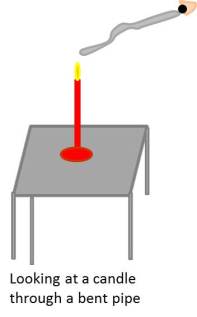
(3) Mirror-
A mirror is an object that reflects light in such a way that object reflects in it.
Types of mirror-
(i) Plane mirror-
Plane mirror is a flat mirror which reflects objects in their proportions and sides of image interchanged.

Eg:- Bathroom mirror etc.
Uses-
(a) Plane mirror is used in beauty parlours.
(b) It is used in bathrooms.
(c) It is used everywhere when we want to see exact image.
(ii) Convex mirror-
Convex mirror are those mirrors whose reflective side rounded outside towards the light source. These mirrors always formed virtual image and covered larger area. The image is always smaller than the object but gets larger as the object approaches the mirror.

Eg:- Outer side of spoon, outer side of ball, reflecting surface of bicycle etc.
Uses-
(a) The passengers – side view mirrors in the cars because they give upright and smaller image. They also covered large area.
(b) Some camera phones uses convex mirror to take self portrait.
(iii) Concave mirror-
Concave mirrors are those mirrors whose reflective side rounded inside towards the light source. Concave mirrors show different image types depending on the distance between the object and the mirror. When object is closer to the mirror, image will be erect and larger in the size. But, when object goes far away from the mirror the image will be inverted and smaller.

Eg:- Inner side of spoon, inner side of ball etc.
Uses-
(a) These mirrors are used in applying make up and in shaving mirrors.
(b)These mirrors are used in reflecting telescope.
(c)In headlamps and solar plant, concave mirrors are used.
(d)These mirrors are used by doctors for examining eyes, ears, nose, teeth and throat.
(e) These mirrors are used in reflectors of torches, headlights of cars and scooters.
(4)Reflection of light-
The process in which direction of light changes by a mirror or shiny surface that falls on it is called reflection of light. The surface of water can also act as a mirror and change the path of light.

Experiment 2
Take a torch cover its glass with a chart having three slits. Place a chart paper on the wooden box and fix a mirror vertically on it. Now direct the light of beam from torch on the mirror. You can see the light beam is making an angle with the mirror. It means light changes its direction.
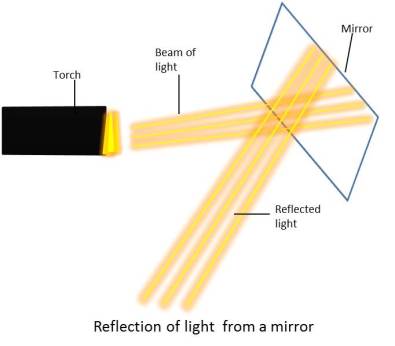
(5)Object-
The thing whose visual impression will be seen through a mirror is called object.
(6)Image-
The visual impression of a thing through a mirror is called image.
(i)Erect image-
An upright image of an object is called erect image.
(ii)Virtual image-
The image which could not be formed on screen is called virtual image. This could be obtained by plane mirror.
(iii)Real image-
An image formed on screen is called real image. Real image can be formed by concave mirrors. If they placed further away from the object, then the image will be inverted.
(7) Images formed by different mirrors-
(i) Images from plane mirror-
(a) An image formed by a plane mirror is erect, virtual and of the same size as the object.
Experiment 3
Put a lighted candle in front of a plane mirror. We can see visual impression of candle on the mirror, it is image of candle. Candle is an object here. Image of candle is exactly the same as object. Image is upright, so it is called erect.

(b) The image will be at the same distance behind the mirror as the object is in front of it.
Experiment 4
Take chess board. Draw a thick line at the mid of the chess and place a plane mirror on it. Place a sharpener at the boundary of the third square. The image of the object will be seen at the boundary of third object. It shows that the image will be made at the same distance behind the mirror as the object is in the front of it.
(c) Sides of image on a plane mirror interchanged but the image does not appear upside down.
Experiment 5
Stand in front of a plane mirror. Raise your right hand. You will find that in the mirror the right appears left.
Write your name on the paper and see it in a plane mirror. You will not be able to read your name because it appears reversed. This is why we can not read ambulance written on the van. But it is done on purpose. When a driver of a vehicle ahead of an ambulance looks in his rear view mirror he can read it.
(ii) Images from concave mirror-
(a) We will get an erect and larger image of an object. But if we increase the distance between object and mirror we will get an inverted and shorter image of object.
Experiment 6
Bring spoon’s inner side near to your face .You will get an erect and larger image of your face. But if you increase the distance between the spoon and face you will get an inverted and shorter image of your face.
(b) The concave mirror gives real image on screen, i.e., paper.
Experiment 7
Take a concave mirror. Hold it in sun and try to get the light reflected by the mirror on a sheet of paper. Adjust paper and you will get a sharp bright spot on the paper. This image is called real image because we can get it on screen, i.e., paper. If we will keep paper in sun it burns because of getting continuous heat from the sun.

(c) We can get a real image which is inverted and larger than object. But if we move object near to concave mirror we will get virtual image on mirror not on screen.
Experiment 8
Take a concave mirror and fix it on a stand. Paste a piece of white paper on the cardboard. It will work as screen. Keep a lighted candle on the table at the distance of 50 cm from the mirror. Move the screen to get a sharp image of candle on it. You will find an inverted and larger than object image. It is a real image.

Now move the candle towards mirror we will get a real image. But if we move candle very close to the mirror we will get image in mirror not on screen. It is a virtual image.
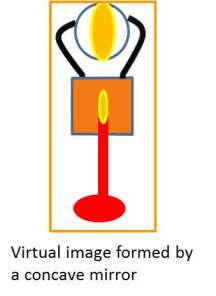
Image formed by a concave mirror for object placed at different distances from it.
| Distance of the object from the mirror | Smaller/larger than the object | Character of the image-
Inverted / erect |
Character of the image-
Real/ virtual |
| 50 cm | Smaller | inverted | Real |
| 40 cm | Larger | inverted | Real |
| 30 cm | Larger | Inverted | Real |
| 20 cm | larger | inverted | Real |
| 10 cm | larger | inverted | Real |
| 5 cm | larger | erect | virtual |
(iii) Images from convex mirror-
(a)Concave mirror always shows an upright and smaller image of object.
Experiment 9
Take a spoon and bring its outside closer to your face you will find an upright and smaller image of your face.
(b)We will get an erect, smaller than object and virtual image.
Experiment 10
Take a convex mirror and fix it on a stand. Keep a lighted candle on the table at the distance of 50 cm from the mirror. Move the screen to get a sharp image of candle on it. You will find an erect and smaller than object image. It is a virtual image. We can get only virtual image from convex mirror.

Image formed by a convex mirror for object placed at different distances from it.
| Distance of the object from the mirror | Smaller/larger than the object | Character of the image-
Inverted / erect |
Character of the image-
Real/ virtual |
| 50 cm | Smaller | erect | Virtual |
| 40 cm | Smaller | erect | virtual |
| 30 cm | Smaller | erect | virtual |
| 20 cm | Smaller | erect | virtual |
| 10 cm | smaller | erect | virtual |
| 5 cm | smaller | erect | virtual |
(8) Lenses are transparent curved optical devices which are used to converge and diverge transmitted light and to form images.
Types of lenses-
(i) Convex lenses-
Convex lenses are thicker in the middle than at the edges. These are converging lenses.

Uses-
(a)These lenses are used in magnifying glasses.
(b)Refracting telescope uses these lenses.
(c) These lenses are used in correction of visual impairments for farsighted people.
(d)Digital cameras have convex lenses.
(e) Our eye has double convex lenses which focuses image at our retina at the back of eye.
(ii) Concave lenses-
Concave lenses are thinner in the middle than at the edges.These are diverging lenses.

Uses-
(a) These lenses are used in camera, binoculars, telescope etc.
(b)These lenses are used in correction of visual impairments as myopia.
(c) These lenses are used in laser beams. The small concave lenses can widen a laser beam to access a specific area.
(9) Images formed by different lenses-
(i) Images from convex lens-
(a) It is a divergence lens.
Experiment 9
Take a convex lens. Place a paper sheet. Put convex lens in the sun. Adjust the distance between the lens and the paper till you get a bright spot on the paper. Paper starts burning after sometime. It will happen with because it is a divergence lens. So, light will divergent and concentrate on one point. The spot on the paper get continuous heat and paper starts burning.

(b) It gives a real inverted image which increases as object moves towards the lens. When object came very near to the lens, it gives us a virtual and erect image.
Experiment 10
Take a convex lens and fix it on a stand. Place a lighted candle at a distance of about 50 cm from the lens. Try to get the image of the candle on the screen. You will get a real inverted image.
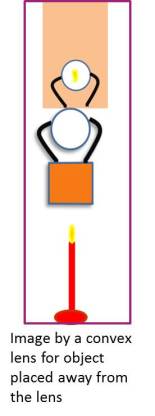

The size of the image increases as object move towards the lens. When object came very near to the lens we get a virtual and erect image.

Image formed by a convex lens for object placed at different distances from it.
| Distance of the object from the lens | Smaller/larger than the object | Character of the image-
Inverted / erect |
Character of the image-
Real/ virtual |
| 50 cm | Smaller | inverted | Real |
| 40 cm | Larger | inverted | Real |
| 30 cm | Larger | Inverted | Real |
| 20 cm | larger | inverted | Real |
| 10 cm | larger | inverted | Real |
| 5 cm | larger | erect | virtual |
(ii) Images from concave lens-
(a)It gives a virtual and erect image. The size of the image is smaller than the size of the object.
Experiment 11
Take a concave lens and fix it on a stand. Place a lighted candle at a distance of about 50 cm from the lens. Try to get the image of the candle on the screen. You will get a virtual, erect image. The size of the image is smaller than the size of the object.

Image formed by a concave lens for object placed at different distances from it.
| Distance of the object from the lens | Smaller/larger than the object | Character of the image-
Inverted / erect |
Character of the image-
Real/ virtual |
| 50 cm | Smaller | erect | Virtual |
| 40 cm | Smaller | erect | virtual |
| 30 cm | Smaller | erect | virtual |
| 20 cm | Smaller | erect | virtual |
| 10 cm | smaller | erect | virtual |
| 5 cm | smaller | erect | virtual |
(10)Rainbow-
Rainbow is a colourful arc appears after rain in the sky when sun is low. Rainbow has seven colours. These are red, orange, yellow, green, blue, indigo and violet.
(12) These seven colours can be seen in soap bubbles and when light is reflected from the surface of a CD.
Experiment 12
Take a glass prism. Allow a beam of sunlight through a small hole in the dark room to fall on the prism. Let the light coming out of the other face of the prism fall on white paper. You can see the all seven colours of a rainbow. This shows that the sunlight consists of seven colours. The sunlight is said to be white light.
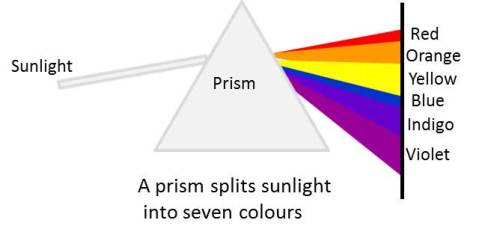
Splitting of light into its seven colour is known as dispersion of light.
(13) Newton’s disc-
A Newton’s disc is a disc divided into sectors of rainbow colours,appears white or grey while spinning it fast.
Experiment 13
Take a cardboard disc and paint it with seven rainbow colours. Then fix it on a stick loosely. Rotate it fast in the daylight. It appears nearly white. This disc is popularly known as Newton’s disc.

(14) Incident ray-
The light ray which strikes any surface is known as incident ray.
(15) Reflected ray –
The ray that comes back from the surface after reflection is known as the reflected ray.
(16) The perpendicular line drawn at the point where an incident ray strike to the reflecting surface is called normal.
(17)Angle of incidence-
The angle between the normal and incident ray is called the angle of incidence (∠i).
(18)Angle of reflection-
The angle between the normal and reflected ray is called the angle of reflection (∠r).

(19)Point of incidence-
The point where incident ray, normal and reflection ray meets known as point of incidence.
(19) Laws of reflection-
(i) The angle of incidence is always equal to the angle of reflection.
(ii) Incident ray, reflection ray and normal are at the same plane.
Experiment-
Take a mirror and a paper sheet. Spread sheet and keep mirror at the edge of the sheet. Keep light dim in room. Now, light a torch through a hole in the piece of cardboard or thick sheet. An incident ray reflected from the mirror. Draw these lines. Their meeting point is point of incidence. A perpendicular from this point is known as normal. Hence, the incident ray, the reflected ray and the normal at the point of incidence lie in the same plane.
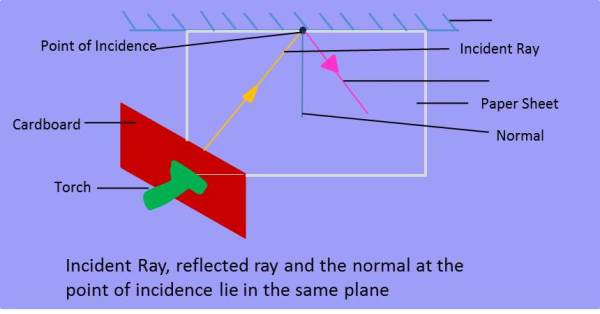
(20) Formation of an image by a plane mirror-
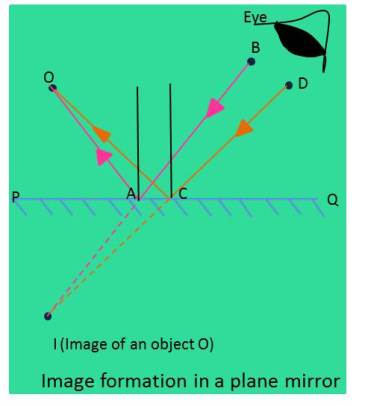
(i) A source of the light O is placed in front of the plane mirror PQ.
(ii) Two incident rays OA and OC are incident on plane mirror PQ.
(iii) Draw two normal at points A and C to the PQ (Mirror).
(iv) Now, draw reflected rays AB and CD.
(v) Extend these reflected rays backwards, if they meet, mark the point I.
(vi) Point I is the image of the O. It is a virtual image.
(21)Lateral inversion –
Lateral inversion is a phenomenon in which an image formed by a mirror the left of the object appears on the right and the right of the object appears on the left.
(22)Diffused or irregular reflection –
Diffused or irregular reflection is the reflection when parallel incident rays reflected from a plane surface are not parallel.
Irregular reflection is caused by the irregularities in the reflecting surface (not smooth) like cardboard surface.

(23) Regular reflection-
Regular reflection is the reflection when parallel incident rays reflected from a smooth plane surface are parallel.
Regular reflection is caused by the smoothness of the reflecting surface.
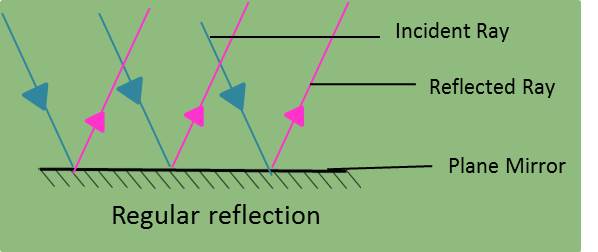
(24) Reflected light can be reflected again.
Eg:- (i)Haircut can be seen with the help of two mirrors.
(ii) Periscopes are used in the submarines, tanks and also by soldiers in bunkers to see things outside.

(25) If two plane mirrors inclined at different angles give multiple images.
Eg:- Kaleidoscope
To make kaleidoscope take three rectangular mirror strips of same size. Join them to make a prism. Fix a glass plate or cellophane sheet at one end. Now put several pieces of glass, shining dust etc. Now fix a piece of cardboard with a hole or cellophane sheet to the other end . Now you can see many patterns inside the kaleidoscope.


(26) Our eyes-
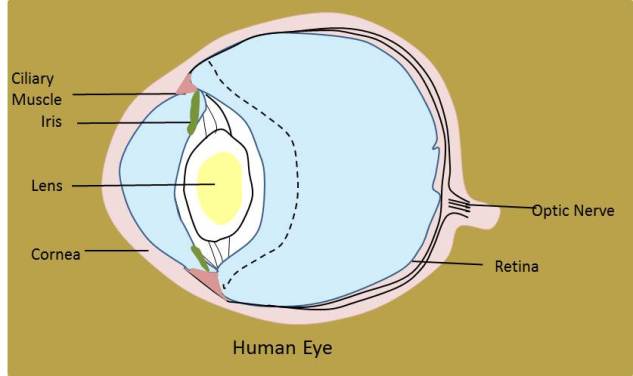
(i) The eye has a roughly spherical shape.
(ii) The outer coat of the eye is white and tough to protect the interior of the eye.
(iii) The transparent front part of outer coat of the eye is called cornea.
(iv) A dark muscular structure behind the cornea, is called iris. It gives distinctive colour to eye. It also controls the amount of light entering into the eye.
(v) The small opening in the iris is called the pupil. Its size is controlled by the iris.
(vi) Behind the pupil of the eye is a lens which is thicker in the centre. The lens focuses light on the back of the eye, on a layer called retina.
(vii) The retina is the innermost and the most sensitive layer of the eye which contains several nerve cells. Sensations felt by the nerve cell transmitted to brain through the optic nerve.
There are two types of nerve cells –
(a) Cones are those nerves cells which are sensitive to bright light.
(ii) Rods are those nerve cells which are sensitive to dim light.
(viii) Blind spot is the spot where no vision is possible. In our eyes at the joint of the optic nerve and the retina there no sensory cells which can send images to the brain to interprets for us.
Demonstration for blind spot-
Mark a cross and a circle on a sheet of paper with the spot to the right of the cross at the distance of 6 – 8 cm in between them. Now, hold paper at the arm length. Close your left eye. Look continuously at the cross while moving sheet towards eyes. The cross will disappear. Now close your right eye and look continuously at the round spot while moving sheet towards eyes. The round mark will disappear. It shows that there is a point on the retina which cannot send messages to the brain when light falls on it.

(xi) The impression of an image persists on retina for about 1/16th of a second. Therefore, if images of an object flashed on our eye more at a rate faster than 16 per second, the eye perceive that object is moving.
Eg:- Movies which flashed objects more than 16 per second.
Experiment
Take a cardboard with two holes in it. Draw a photo of bird at front side of the cardboard and draw a photo of cage on the reverse side of the cardboard. Now, tie two separate threads from the holes and twist threads fast. You will see that bird in the cage. It happens because objects flashed faster than the 16 per second.
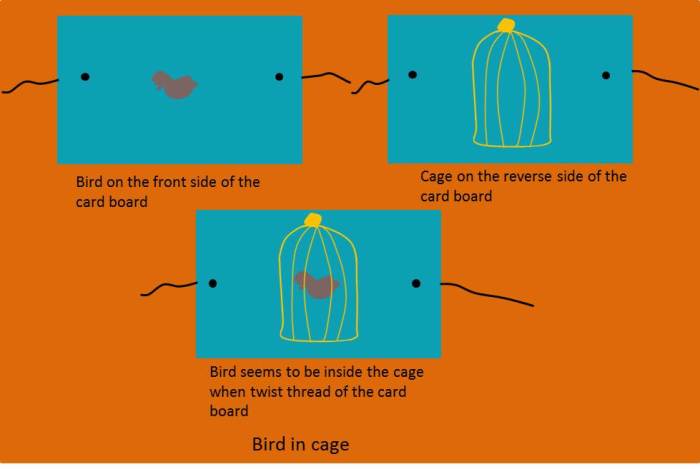
(x) Eye lids are the upper and lower part of the eye which cover the eye when we closed it.
(xi)The most comfortable distance at which a human can read is 25 cm.
(x) Some time we cannot see objects clearly which can be corrected by the use of different lenses.
(xiii) Cataract is a problem of no or incorrect vision of our eyes when lens become foggy. The problem of cataract can be corrected by inserting new artificial lens and removing opaque original lens.
Care of the eyes-
(i) If you have difficulties in reading or seeing objects, use suitable spectacles.
(ii) Proper light is very necessary for eyes. Less light causes headache and eyestrain. The sharp light or power lights like sunlight, a laser torch etc. are also very harmful for eyes. These power lighst can injure retina of eyes.
(iii) Do not look at the sun or a powerful light directly.
(iv) If any foreign particles go in to the eye, wash your eyes with clean water immediately. But never rub your eyes and go to the doctor.
(v) Always wash your eyes frequently with clean water.
(vi) Keep your book at normal distance while reading.
(vii) Always have vitamin A rich diet like raw carrot, broccoli and green vegetables. Lack of vitamin A causes night blindness.
(27)Visually challenged-
Visually challenged persons cannot see or have less vision but they develop their other senses more sharply. They identify things by touching and listening to voices more carefully.
(28)Braille system-
Braille system is developed for the visually challenged persons to help them read and write.
(i) This system was developed by Louis Braille in 1821.
(ii) The present system is adopted in 1932.
(iii) Mathematics, science and many languages can be read and write in Braille code. Braille codes are embossed on Braille sheets help them to recognize words by touching.
(29) Types of aids for people having weak eyesight-
(i) Optical aids include bifocal lenses, contact lenses, tinted lenses, magnifiers and telescopic aids.
(ii) Non optical aids include visual aid, tactual aid (using the sense of touch like Braille method), auditory aids (using the sense of hearing) and electronic aids (like talking calculators).
(30) Eyes of animals other than human
| SN | Name of the animal | Eyes |
| 1. | Crab | Can look all around. |
| 2. | Butterfly | Made up of thousands of little eyes. |
| 3. | Owl (Night bird) | Large cornea and large pupil with large number of rods and only a few cones in retina. |
| 4. | Lite, eagle (Day bird) | More cones and few rods in retina. |
Helping Topics